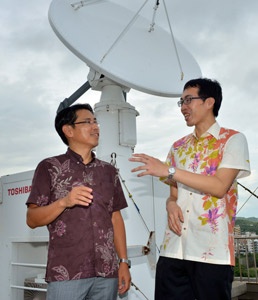Two typhoon experts at University of the Ryukyus collaborate

Two meteorologists, assistant professor Kosuke Ito (left) and associate professor Hiroyuki Yamada hold a conversation on typhoons in front of Doppler radar at University of the Ryukyus.
October 7, 2015 Ryukyu Shimpo
Two typhoon experts, 44-year-old associate professor Hiroyuki Yamada and 33-year-old assistant professor Kosuke Ito have formed a rare partnership in their research into mesoscale meteorology and numerical weather prediction systems in the Geoscience Section at the Department of Physics and Earth Sciences, University of the Ryukyus. Masahide Furukawa, the associate dean of the department, says, “University of the Ryukyus is the only one among the other regional universities where experts in observation and numerical prediction work together.” The department is expected to be a hub for studying typhoons.
Yamada worked as a researcher at the Japan Agency for Marine-Earth Science and Technology before moving to Ryudai in August 2012. His research examines the strength of wind and rain using Doppler radar that analyzes electromagnetic waves from typhoons.
While the Japan Meteorological Agency predicts the strength of typhoons by analyzing cloud distribution using satellites, Doppler radar provides more accuracy. However, there are challenges as Doppler radar can only fully assess the strength of typhoons within a 200-kilometer radius and above a 2-kilometer altitude. Future researches are expected to improve the technology.
Along with analyzing the rapid development of typhoons and improving the accuracy of predictions, such research is also aimed at contributing to disaster management. Yamada is passionate about the work.
“I want to establish methods that analyze strengths of typhoons more accurately such as equipping aircrafts with the observation system in future,” he says.
Ito has worked at Ryudai since April last year, while also serving as a visiting researcher at the Forecast Research Development of the Meteorological Research Institute in Tsukuba City, Ibaraki Prefecture. His research considers atmospheric and ocean water conditions to predict typhoon intensity using a unique method called “high-resolution atmosphere-ocean coupled model”. Although the calculation takes a time, the result is more accurate than the model used by the Meteorological Agency.
The model employed by Ito uses the super computer K, and his research has drawn acclaim for being one of next generation post K-projects. Ito declares he will “aim for the cutting edge of simulation research”.
Yamada is eager to work with Ito, saying, “I would like to contribute to development of the atmospheric researches in Okinawa, complementing Ito’s work”. Ito is also enthusiastic about the partnership.
“We are discussing visions for research 5 to 10 years from now.”
(English translation by T&CT and Sayaka Sakuma)
Previous Article:Katsuren Peninsula: rich sea where coral reefs live
Next Article:Sea turtles raised from artificial hatching of eggs produced by mother that died in accident released
[Similar Articles]
- Anesthesiologist Dr. Sakura Kinjo wins Rocky Challenge Prize for bridging Japan-US academic exchange
- Nobel Prize-winning physicist Takaaki Kajita speaks to high school students at OIST, tells of the mysteries of space and the “strength to persevere”
- OIST to set up venture capital company
- World’s First Technique to Identify Fish Species from a Bucket of Water
- Japan’s Self-Defense Force opens radar station in Yonaguni
 Webcam(Kokusai Street)
Webcam(Kokusai Street)


